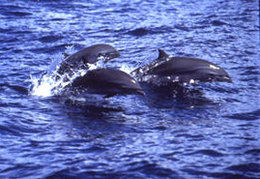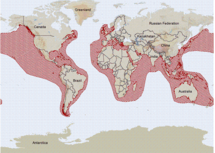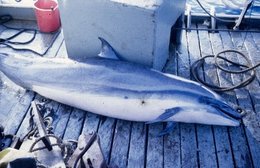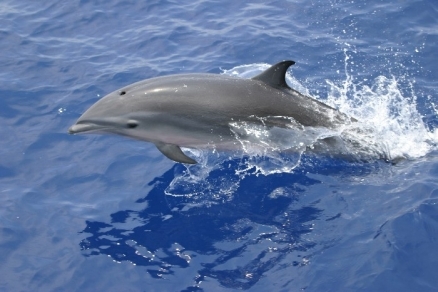Fraser's dolphin
Fraser's dolphin is a tropical dolphin first scientifically described in 1956, from a single individual washed up on a beach in Borneo, but the species was not actually recorded alive until the 1970s. The species, a marine mammal, is a member of the family of oceanic dolphins, and part of the order of cetaceans.
The Lagenodelphis hosei derives its common name from the scientist, Francis Fraser, who was working at the British Museum in 1895. Dr. Fraser described this species using a lone skull bone of the dolphin found on a beach in Sarawak, Borneo.
Fraser's dolphin is highly sociable, and lives in groups ranging from 100 to 2500 individuals, and also associates with other species of dolphins. This dolphin is believed to only be found in deep waters, because its preferred food lives at significant depths. Also, it is mostly recognizedfor its dark grey or black stripe that runs from its eye to its flipper and anus. This stripe is thought to vary depending on the group of dolphins' geographic location.
 Fraser's dophins. Source: MarineBio.org Fraser's dophins. Source: MarineBio.org
|
 Size comparison of Fraser's dolphin to an average adult. Source: Chris Huh Size comparison of Fraser's dolphin to an average adult. Source: Chris Huh
|
|
Scientific Classification Kingdom: Animalia (Animals) |
|
Common names Bornean dolphin |
Contents
Physical description
Fraser's dolphin can be identified by the characteristic stocky body, short beak, small flippers and small tail fin. They also havea triangular or slightly curved dorsal fin. Their body bears a striking color pattern,however, itvaries with both age and sex. The back is brownish-grey, the lower sides of the body cream-coloured, and the belly is white or pink. A prominent black or greystripe runs along the side of the body from the eye to the anus.While adult males have a thick stripe which forms a 'bandit mask,' the adult females' stripe varies.In young dolphins, the stripe is faint or completely absent.
Reproduction
Breeding appears to be year-round with a possible peak in the summer months. Mating in Fraser's dolphin is believed to be promiscuous, and mature females give birth approximately every two years to a meter-long calf.The gestation period is thought tolast about11 to 12.5months. Sexual maturity of both sexes occurs at the age of seven years, while females are thought to mature at anywhere from five to eight years of age. There is no sexual dimorphism except for the size and shape of the dorsal-fin, with male fins being larger than female fins.
Behavior
Fraser's dolphins are often found in large pods with other cetaceans. They areespecially found with the Melon-headed whale, buthave also been found with the Short-finned pilot whaleand many other dolphin species. Groups tend to be large, ranging from 100 to 2500 members.
A school of Fraser's dolphins moves quickly, andwhen fleeing from ships, these dolphins can reach speeds of 28 kilometres per hour. On very rare occasions, they have been seenriding the bow waves of boats, porpoising (leaping clear of the water when surfacing to breathe).
Distribution
These dolphins are restricted to tropical and subtropical waters. They are know to inhabit deep, oceanic waters. However, in places where deep water lies close to the coast, such as in the Philippines and Indonesia, they have also been seen.
 Fraser's dolphin distribution. Source: John Lagrange/WoRMs
Fraser's dolphin distribution. Source: John Lagrange/WoRMs
Habitat
They are know to inhabit deep, oceanic waters. However, in places where deep water approaches the coast, such as in the Philippines and Indonesia, they have also been sighted.
Predation
No predation on this species has been observed, but the Killer whale,and false killer whale are thought to probably occasionally take these dolphins as prey. Also, sharks are thought to predate this species. In fact, wounds caused by the peculiar Cookie-cutter shark (Isistius brasiliensis) have been found on this species.
Food habits
Fraser's dolphins' preference for deep waters is thought to be because of their food preference. This dolphin primarily feeds on cuttlefish, squid, shrimp, andspecies of crustaceans and fish. Their food preference requires the dolphin to dive down to feed at depths of 250 to 500 meters. Because their food preferences live at these depths, they do not compete with fisherman for tuna or other pelagic fish.
Conservation status
 Fraaser's dolphin. Source: WoRMs/John Lagrange In 1992, the Department of Agriculture of the Philippines banned the 'taking or catching, selling, purchasing, possessing, transporting and exporting of dolphins. This order has not stopped dolphin hunting, but seems to have decreased the sale of dolphin meat openly in the market. The distribution, migratory behavior, abundance and by-catch rates of Fraser's dolphin are poorly known. Because of the lack of knowledge, further research on this sociable dolphin is likely to be the first step in the development of any conservation measures
Fraaser's dolphin. Source: WoRMs/John Lagrange In 1992, the Department of Agriculture of the Philippines banned the 'taking or catching, selling, purchasing, possessing, transporting and exporting of dolphins. This order has not stopped dolphin hunting, but seems to have decreased the sale of dolphin meat openly in the market. The distribution, migratory behavior, abundance and by-catch rates of Fraser's dolphin are poorly known. Because of the lack of knowledge, further research on this sociable dolphin is likely to be the first step in the development of any conservation measures
This species is listed by the IUCN as least concern (LC).
Threats
In certain areas this dolphin remains vulnerable to the threat of hunting and bycatch. In the lower Antilles, Indonesia and the Philippines, this species has been killed by harpoon for meat consumption by humans. Some are also taken in fisheries in Taiwan and Japan, and in many areas Fraser's dolphin is often caught unintentionally as bycatch in fishing gear, representing a form of overfishing.
References
- Encylopedia of Life. 2011. Lagenodelphis hoseiFraser (1956) Fraser's dolphin
- MarineBio.org
- U.S. NOAA Fisheries Office of Protected Resources
- IUCN Red List (November, 2008)
- Dolar, M.L.L. (2002) Fraser's dolphin. In: Perrin, W.F., Würsig, B. and Thewissen, J.G.M. Eds. Encyclopedia of Marine Mammals. Academic Press, London.
- Jefferson, T.A. and Leatherwood, S. (1994) Lagenodelphis hosei. Mammalian Species, 470: 1 - 5.
- CITES (December, 2007)
- Perrin, W.F., Best, P.B., Dawbin, W.H., Balcomb, K.C., Gambell, R. and Ross, G.J.B. (1973) Rediscovery of Fraser's Dolphin Lagenodelphis hosei. Nature, 241: 345 - 350.
- Ross, G.J.B. (2006) Review of the Conservation Status of Australia's Smaller Whales and Dolphins. Department of the Environment and Heritage, Canberra, Australia.
- Dolar, L. (2008) Pers. Comm.
- CMS Species Factsheet (January, 2008)
- CMS (January, 2008)
- Banks, R. C., R. W. McDiarmid, and A. L. Gardner. 1987. Checklist of Vertebrates of the United States, the U.S. Territories, and Canada. Resource Publication, no. 166. 79
- Borges, P.A.V., Costa, A., Cunha, R., Gabriel, R., Gonçalves, V., Martins, A.F., Melo, I., Parente, M., Raposeiro, P., Rodrigues, P., Santos, R.S., Silva, L., Vieira, P. & Vieira, V. (Eds.) (2010). A list of the terrestrial and marine biota from the Azores. Princípia, Oeiras, 432 pp.
- Felder, D.L. and D.K. Camp (eds.), Gulf of Mexico–Origins, Waters, and Biota. Biodiversity. Texas A&M Press, College Station, Texas.
- Fraser, F.C., 1956. A new Sarawak dolphin, p. 496. Sarawak Museum Journal, 7:478-503.
- IUCN (2008) Cetacean update of the 2008 IUCN Red List of Threatened Species.
- Jefferson and Leatherwood (1994) Lagenodelphis hosei. Mamm Species, 470:1-5.
- Jefferson, T.A., S. Leatherwood and M.A. Webber. 1993. Marine mammals of the world. FAO Species Identification Guide. Rome. 312 p.
- Jefferson, Thomas A., and Stephen Leatherwood. 1994. Lagenodelphis hosei. Mammalian Species, no. 470. 1-5
- Mammalian Species #470
- Mead, James G., and Robert L. Brownell, Jr. / Wilson, Don E., and DeeAnn M. Reeder, eds. 2005. Order Cetacea. Mammal Species of the World: A Taxonomic and Geographic Reference, 3rd ed., vol. 1. 723-743
- Perrin, W. (2010). Lagenodelphis hosei Fraser, 1956. In: Perrin, W.F. World Cetacea Database. Accessed through: Perrin, W.F. World Cetacea Database 2011-02-05
- Ramos, M. (ed.). 2010. IBERFAUNA. The Iberian Fauna Databank
- Rice, Dale W. 1998. Marine Mammals of the World: Systematics and Distribution. Special Publications of the Society for Marine Mammals, no. 4. ix + 231
- UNESCO-IOC Register of Marine Organisms
- Walker's Mammals of the World, fifth edition; Nowak, R. ed.; 1991; Johns Hopkins University Press. pp. 990-991
- Wilson, Don E., and DeeAnn M. Reeder, eds. 1993. Mammal Species of the World: A Taxonomic and Geographic Reference, 2nd ed., 3rd printing. xviii + 1207
- Wilson, Don E., and F. Russell Cole. 2000. Common Names of Mammals of the World. xiv + 204
- Wilson, Don E., and Sue Ruff, eds. 1999. The Smithsonian Book of North American Mammals. xxv + 750
- van der Land, J. (2001). Tetrapoda, in: Costello, M.J. et al. (Ed.) (2001). European register of marine species: a check-list of the marine species in Europe and a bibliography of guides to their identification. Collection Patrimoines Naturels, 50: pp. 375-376
